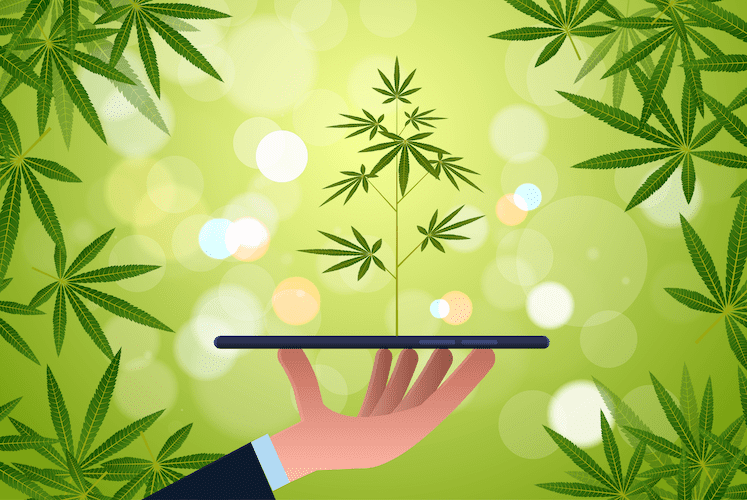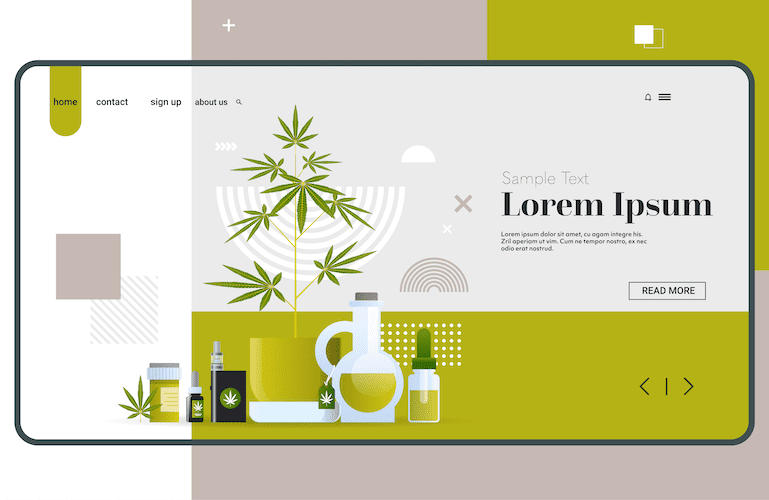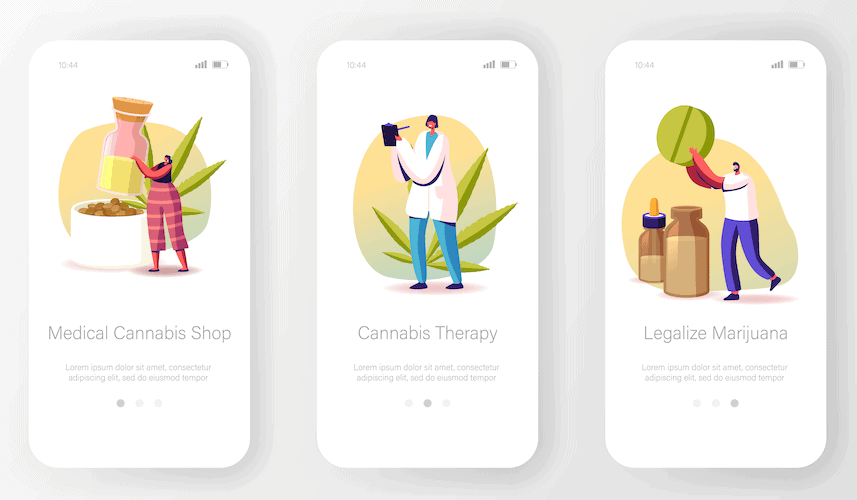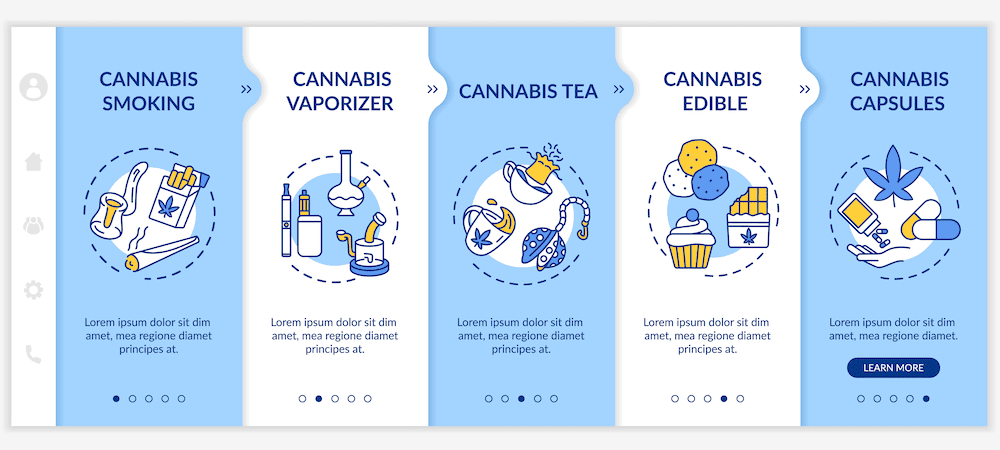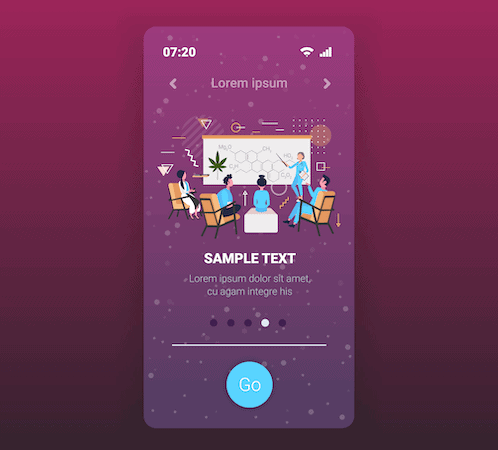Smoking pot during the hot summer of 2003 on the outskirts of Panama City Beach, Florida, I would’ve never thought I’d be writing a blog on how to create a marijuana delivery app.
Fast forward to 2022, and we see licensed dispensaries popping in more and more states. Even Apple gave in and allowed apps selling hemp in the App Store for the first time last summer. Now it’s only a matter of time before Uber Hemps and GanjaDash have crowded the cannabis market.
So if on-demand cannabis app development is your thing, you’re in the right place. No lengthy interludes, I promise.
Top Takeaways:
- Creating a marijuana delivery app requires building more than one mobile app. Besides the customer-facing application, you will also need to develop an app for couriers with on-demand delivery jobs and routes; plus a web dashboard to manage these mobile apps.
- Artificial intelligence and the Internet of Things have the most substantial potential to spearhead your cannabis delivery application over the competition.
- Choosing a white-label solution over custom cannabis app development will significantly limit your ability to push out innovative features and enhance the app based on user feedback.
Table of Contents:
- Marijuana Delivery App Market Overview
- Must-Have Features
- Medical Marijuana Delivery App Development Steps
- How Much Does it Cost to Build an App Like Uber for Marijuana
- Legal Requirements for a Cannabis Delivery Business
- Our Experience in Marijuana Delivery App Development
Marijuana Delivery App Market Overview
The market for cannabis delivery apps is booming amid the widespread legalization of marijuana in the United States. With licensed dispensaries expanding in multiple states, the demand for reliable and convenient cannabis delivery services is on the rise. According to industry experts, this trend is projected to persist in the upcoming years, making it an opportune time for entrepreneurs to make a cannabis delivery app.
- As per industry reports, a significant 44% of medical marijuana consumers in the United States rely on weed delivery services for their purchases.
- From2019 to 2021, during the period of the pandemic, the cannabis industry experienced a remarkable annual growth rate of 21%.
Market Forecast
The future looks promising for marijuana delivery apps. As more states legalize the recreational and medical use of cannabis, the customer base for these services is expected to expand. This presents a lucrative opportunity for entrepreneurs and investors looking to tap into the cannabis industry. Let’s take a look at some verifiable statistics that highlight the popularity and potential of marijuana delivery apps:
- Market Value: By 2025, the cannabis delivery industry is estimated to reach a remarkable market value of $30 billion.
- Global Revenue: The revenue for the global cannabis market is projected to reach a valuation of $47.2 billion by the end of the forecast period.
- Current Market Size: The market size of the cannabis industry is currently estimated to be over $8 billion.
- Growth Projection: The cannabis industry is expected to grow by $22 billion in 2022 and reach a worth of $35 billion by 2025.
The bottom line is the custom app development for cannabis market is expected to grow significantly in the upcoming years, as demand for an efficient and user-friendly delivery solution increases.
Top 3 On-Demand Cannabis Delivery Apps
Keeping an eye on the top performers in the industry can provide valuable insights and inspiration for creating a successful marijuana delivery app. These apps are continuously evolving to meet the needs and expectations of consumers.
Eaze
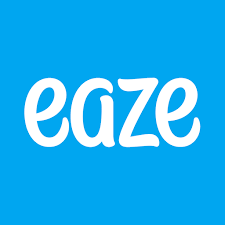
Key Features: Extensive product selection, user reviews, multiple payment options, real-time order tracking (delivery person on a map), reliable delivery service, and a user-friendly interface.
Time on the Market: since 2014.
Leafly
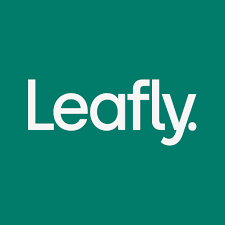
Key Features: Strain information database, dispensary locator, user reviews and ratings, personalized recommendations, deals and discounts, and a user-friendly interface.
Time on the Market: since 2010.
WeedMaps

Key Features: Dispensary and delivery service locator, comprehensive menu browsing, user reviews and ratings, online ordering, deals and promotions, and a user-friendly interface.
Time on the Market: since 2008.
Please note that all these and other popular apps with a focus on medical marijuana app development were able to introduce on-demand delivery only in 2021.
Must-Have Features in a Cannabis Delivery App
What essential features should you foresee to create a cannabis app powerful enough to get real traction with users?
Maps and navigation
Since we’re dealing with a delivery type of CBD app, everything that has to do with maps gets priority over other app features. After all, popular apps like DoorDash became hits mainly due to their courier tracking features and location-aware shopping. Customers love being able to track order delivery.
So, during medical cannabis delivery app development you will need to pay attention to such features as:
- live GPS tracking
- points of interest based on coordinates
- GPS-enabled routing for creating optimal routes
Related: Location based app development guide
User authentication and ID verification
Since recreational use of marijuana is still legal only in 23 states, three U.S. territories, and D.C. and medical use (legalized in 38 states) requires a special marijuana recognition card, your app has to verify the user. The most common approach is to integrate with identity verification solutions like GetID.
Suppose you plan on selling marijuana not only for recreational and medical purposes but also want to offer telemedicine consultations. In that case, you will require physician identity verification too. You should probably stick with mhealth app developers in that case.
Loyalty program
Retaining existing customers is often more complicated than onboarding new users, and that’s true for cannabis ordering & delivery app development, too.
A rewards program that allows users to earn points for discounts is an excellent way to establish loyalty. Another similar approach is to set up a subscription service for “club members” only who enjoy perks not available to the general public.
Notifications
Another retention strategy is to let customers know about new products, flavors, discounts, and other events via push notifications. We just need to include separate toggles for different types of notifications, and some (e.g., delivery notes) should be turned off only via phone settings.
Dynamic notifications a la Uber show delivery time and order status right on the lock screen.
Catalog
Finally, there needs to be a marketplace, right? A detailed product catalog with pot strides, accessories, smoking devices, and other related products you can find in a licensed marijuana dispensary. Most importantly, only individual customer preferences and location should determine what they see in the catalog.
Customers should have the option to search for a sample by filtering through user reviews. As you build your on-demand cannabis delivery app, envision an AI engine processing user reviews, identifying major sensations, and attributing smaller or greater weight to each. So a newbie can find something quickly for imagination, pain relief, relaxation, energy, etc.
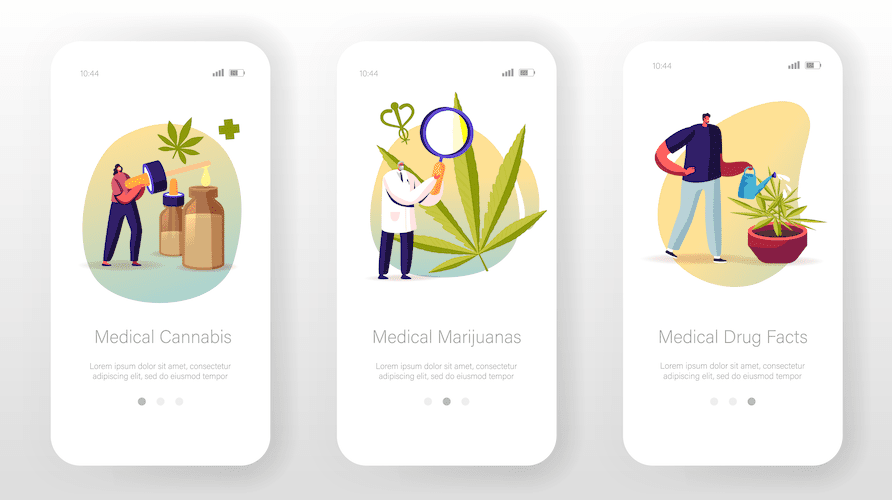
- order history
- profile (with users’ email addresses)
- user registration
- social media integrations
- contact information
Medical Marijuana Delivery App Development Steps
What does it really take to create an app like Uber for marijuana? Let’s go through all required steps one at a time.
Step #1: Discovery
How well do you know your customers?
The first thing on your list when you build a cannabis app should be getting to know your customers. Are you looking to serve people seeking medical relief, or is a recreational group your target audience?
Will you work with a single store or aggregate CBD-infused products from different dispensaries? For the latter, you might want to read up on how to create an on-demand application.
As you understand, the business model (and therefore user stories) will be different for based on your business needs: say for cannabis event organizers and cannabis vendors.
The more you know about your users, the better you tailor the mobile experience to their needs. After all, you may want to optimize your solution for the medical and recreational cannabis business models.
You’re building more than one mobile app
The next big thing is to realize that if you want to build a marijuana delivery app, you will be working on more than a single mobile application.
Even if you decide to skip developing a dedicated delivery app for drivers and use text messaging instead, you’ll still need a web dashboard (at least for order management).
This web admin panel, accessible to you and your staff only, is where you will:
- keep the app’s catalog up-to-date,
- manage orders, refunds, etc.
- run notification campaigns
- track various performance metrics
The dashboard should also support user management, updating the list of cannabis stores (e.g., their phone numbers, nearby dispensaries, product description, etc.) and comms with service providers working with your marijuana business.
ROI-based product-market fit
As a result of the discovery phase, you’ll have a rough outline of your business plan and a list of features, with 2-3 of them having the most ROI potential. Coupled with a basic understanding of required technologies, that makes up a good starting point for on-demand marijuana app development.
In terms of technologies, there’s not much to choose from, really. You pick a platform: iOS, Android, or both. Your developers suggest if you’re better off creating a cross-platform app or two separate native applications. Finally, they pick something for the web app, which is pretty standard these days: React + Node.js.
You’re now set to proceed to the next custom cannabis app development step.
Step #2: User experience
Now that you have a rough plan, it’s time to morph your app idea into a tangible form. Instead of starting to develop a cannabis delivery app right away, we first need to design the customer experience. No coding yet.
How do you design user experience?
You may already have some ideas or sketches of what the app should look like. However, I recommend that you let professionals tackle this task.
Related: 7 steps to designing a successful app
Designers don’t just sit and start drawing random screens because they caught a glimpse of this or that feature in a popular app. They start by jotting down so-called user journeys. What steps do users need to take to accomplish desired actions?
Prototyping is your everything
Based on user journeys, UX/UI designers can start drawing the interface for all main screens. They begin with mere sketches and proceed to polish them into high-fidelity wireframes.
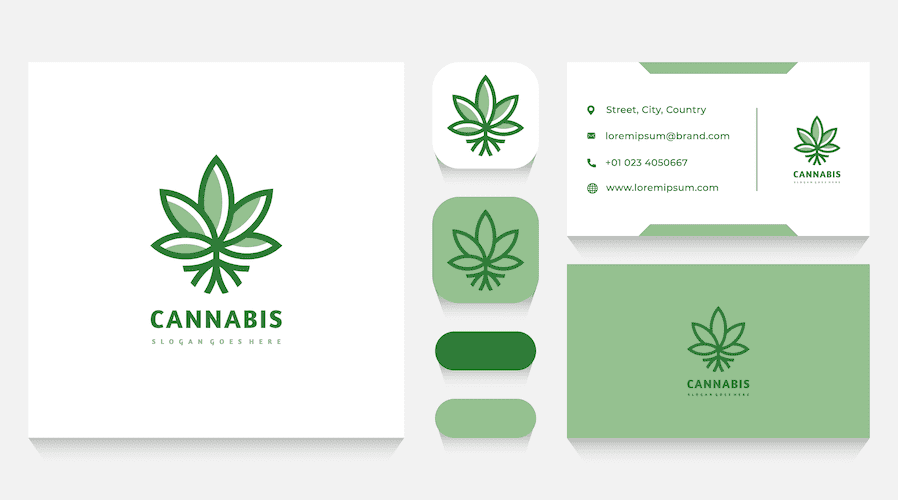
Why waste time on prototyping, again?
The practice of rapid prototyping prevents you from spending the development budget before you hit the perfect product-market fit. Experimenting with design is considerably less expensive than coding the same screens from scratch, only to discover that users don’t really know how to use a feature or don’t need it.
Related: Create a Medical App in 5 Steps
Anything else I should know about the UX design phase?
Developers still contribute at this stage by verifying the design from the technological point of view:
- is it too hard to code?
- can it be replaced with default patterns without compromising the app’s quality?
- does the design follow Apple’s and Google’s development best practices?
- what brand-new features in mobile OSs can we take advantage of?
Also, remember that if you want a dedicated driver’s app, you need to prototype and test it with drivers too.
Finally, pay attention to designing micro UX experiences like home screen widgets that allow users to order cannabis with a single tap.
Step #3: Coding
Coding in custom cannabis mobile app development is the most enigmatic step. To a business owner, this phase may look like a programmer staring into a screen with symbols and typing endless lines of abracadabra, right?
Well, there’s definitely more than that, especially if your app developers practice agile.
What does agile development look like in practice?
First and foremost, agile means a mobile app development company can adapt on the go while developing a cannabis delivery solution. That means if there’s a chance to get better traction by changing a feature or using a different technology, we go for it.
Of course, developers still stare at the screen, typing in magical commands. However, they also participate in daily and weekly meetings to make sure the development team makes progress.
Related: Agile App Development: The Ultimate Guide
QA engineers run their tests, UI/UX designers work on the screens that were not part of the prototype, DevOps sets up the continuous integration and delivery pipeline. And all of that is orchestrated by a project manager.
Often, business owners only (and fortunately) get to deal with the interim results as the team releases a new version of the app every two weeks or so during ganja delivery app development.
Developing core location features
Location features are the most critical part of any delivery business.
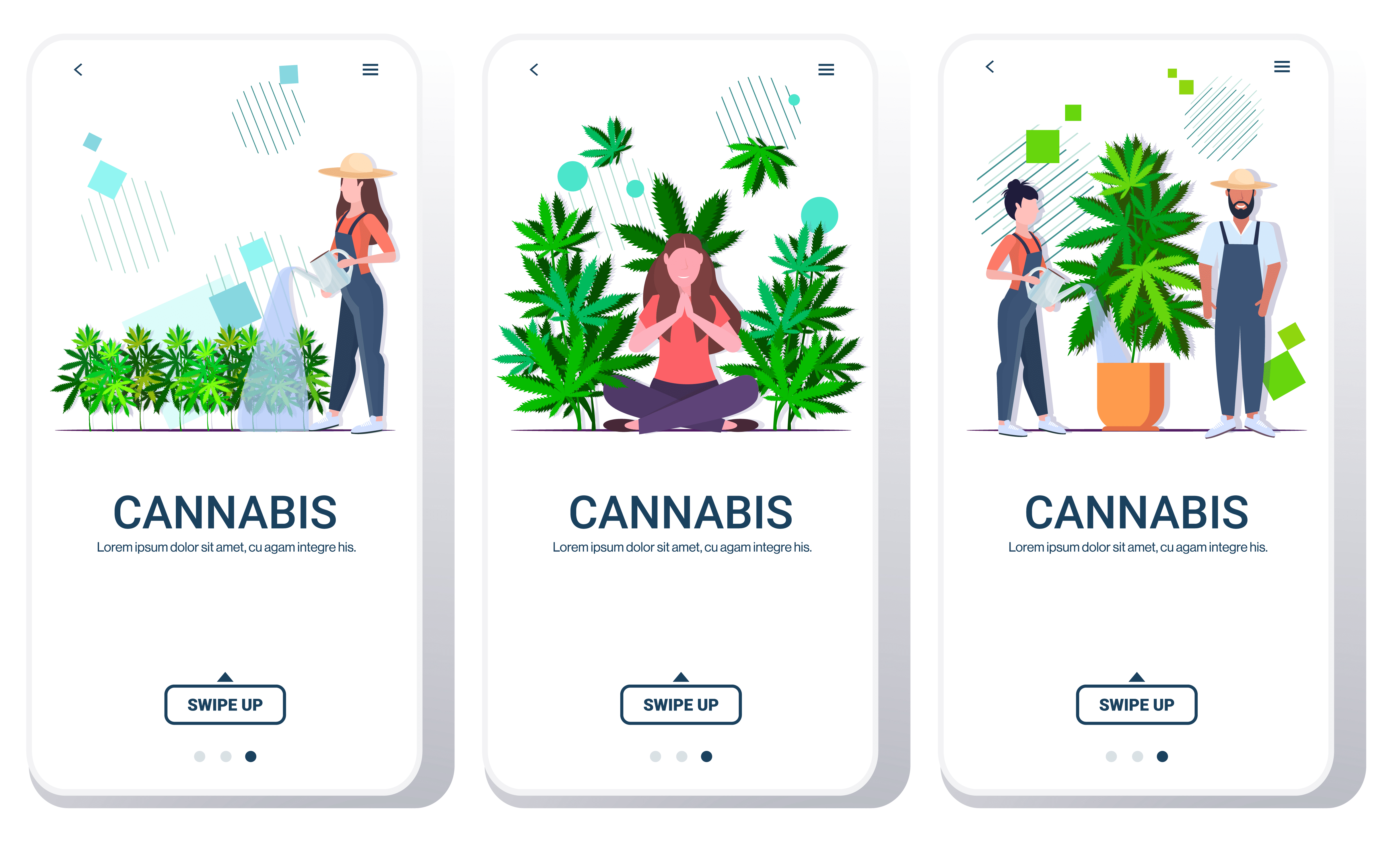
Of course, the bootstrap version is to send the delivery address to drivers via text messages. However, as you start getting more and more orders, you will need a dynamic system. Something for distributing orders automatically based on couriers’ proximity and the ability to combine multiple orders into a single dispatch. Something to ensure that every order is delivered on time — that’s the baseline for all online delivery services
Tech-wise, you’d be better off with Google Maps SDK for a cross-platform app, or go with Apple Maps/Google Maps if you want two separate native apps. And in case you want to get a little more creative and edge out your competitors, your devs should eye GraphHopper, Waze, and other similar third-party APIs.
What payment integrations can we use?
Most states still forbid paying for pot with credit cards. So, make sure the payment provider you integrate with supports debit cards and bank payments end-to-end. Fortunately, most modern payment gateways, like Braintree or Stripe, work with debit cards.
Notifications — a big deal
Since notifications will be a big part of creating an engaging experience for your customers, you’d want to rely on a platform like Pushwoosh or similar. Running multiple campaigns targeted at different user demographics can be pretty challenging and time-consuming, which is why a notification platform is a must.
How devs can spice up medical marijuana delivery app development
We can get very creative with Uber for marijuana app development. The AI/ML spin alone can add a ton of value:
- super-personalized recommendations
- a chatbot ready to tackle users’ questions
- automatic THC/CBD level detection from photos
Or how about an IoT-based smart smoking gadget, able to detect the customer’s mood and order an appropriate stride of legal marijuana? As more states legalize recreational cannabis, I’m sure we’ll see more innovative app solutions on the edge of mobile and IoT in this niche.
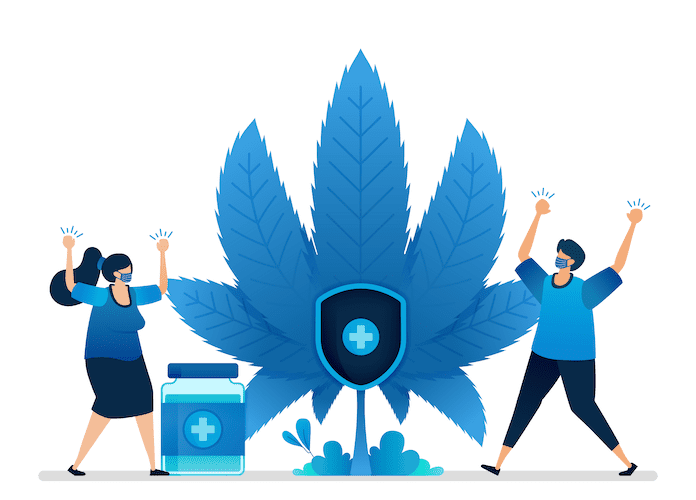
Related: How to Build a Mental Health App
Step #4: Release
Once the app has been developed, it’s time to upload it to the App Store and Google Play. The submission process is not trivial, but you should have no problem with Apple (they also won’t take a cut on sales) selling the product right from the app.
As for Google, they are still cautious, and your customers will need to purchase through a mobile website. So, make sure that the software looks and works well on mobile screens.
Related: Healthcare app development
Step #5: Maintenance
As you already know, once the app is in the mobile stores, the story just begins. Hopefully, your team added some analytics service during on-demand cannabis delivery app development. Why?
Because your best tool to grow the audience is by monitoring how users interact with the app, where they have issues, what’s the best moment to show a rate-me dialog, etc. All this information eventually turns into new features and updates.
Obviously, a successful app keeps evolving together with the market.
If you’ve equipped your app with analytics tools like Mixpanel, you’re in a better position to take advantage when the tide turns. Other platforms, like Crashlytics, will be indispensable for catching unexpected issues and fixing them for the next update.
And that’s the essence of marijuana app development process for creating a standout online cannabis delivery solution.
How Much Does it Cost to Build an App Like Uber for Marijuana
The cost to make a cannabis app (MVP: minimum viable product) starts at around $60,000-$80,000. Please keep in mind that a lot will depend on how many platforms you want to cover (smartwatches and tablets besides smartphones) and how many integrations the app will support.
The cost to develop a full-fledged platform with delivery apps, courier software, and web dashboard from scratch may well end up in the range of $400,000. On par with the delivery app development cost in general, not just for the cannabis sector.
Legal Requirements for a Cannabis Delivery Business
Operating a cannabis delivery business requires strict adherence to legal requirements to ensure compliance with state and local regulations. While the provided context does not mention specific legal requirements, it highlights the importance of legal compliance in this industry.
Recreational and Medical Use Legalization
Recreational use of marijuana has been legalized in 23 states, three U.S. territories, and D.C., while medical use is legalized in 38 states, four out of five permanently inhabited U.S. territories, and the federal District of Columbia.
It is crucial to familiarize yourself with the specific laws and regulations around legal cannabis in your state to operate a cannabis delivery business legally. Each state may have different licensing requirements, product restrictions, and operational guidelines that need to be followed.
Navigating Legal Compliance
When starting a cannabis delivery business, it is essential to consult with legal professionals who specialize in this field. They can provide valuable guidance on obtaining the necessary licenses and permits, ensuring compliance with packaging and labeling regulations, and implementing proper security measures. Navigating the legal landscape of the cannabis industry is crucial to establishing a successful and legally compliant delivery service.
Our Experience in Marijuana Delivery App Development
Alas, some of the most exciting projects we work on are under the mist of NDA. All I can say is we’re working with an energetic startup that got onto CB Insights’ radar as one of the pioneers in cannabis app development. The company produces an IoT gadget allowing companies to detect if their employees have been using marijuana recently.
If you are ready to start a cannabis delivery business and need help with its digital aspect, reach out today.
Related Articles:
[This blog was originally published on 10/28/2023 but has been updated for more recent data]
Frequently Asked Questions
How long does it take to create a marijuana delivery app?
Six-eight months for an MVP version.
What mapping service can you recommend?
Google Maps SDK is ideal for the initial MVP version of the customer-facing and courier applications. That will help to lower the initial cost of developing the software.
Will I face an issue when submitting the app to the app stores?
Not with the App Store. However, remember that Google Play won’t accept applications with in-app cannabis purchases. You’ll need to route that via a browser.
Do you have any ideas for making my app special?
Everybody has ideas. What matters is whether we can validate these ideas against the target audience. Here, try video reviews and let users rate them up and down.
What tech stack should I use to build an app like uber for marijuana?
Swift for iOS, Kotlin for Android, or React Native/Flutter for both platforms.
[This blog was originally published in March 2022. It has been updated for more recent information.]
